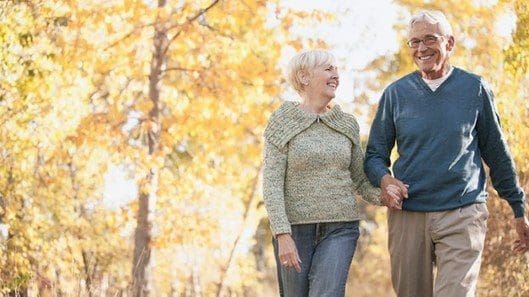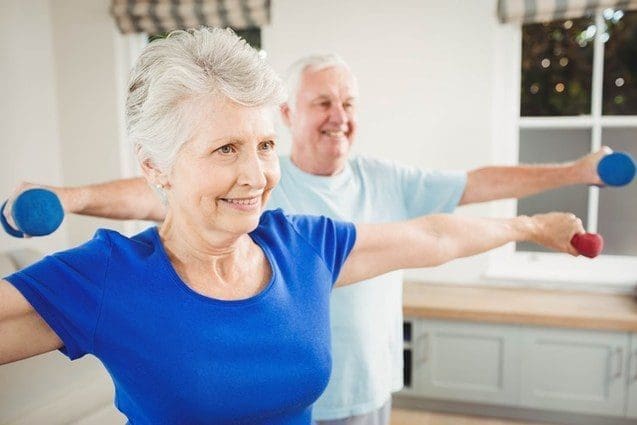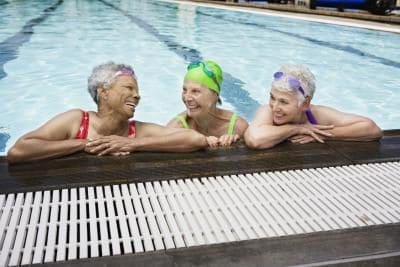
by Dr Alex Jimenez DC, APRN, FNP-BC, CFMP, IFMCP | Nutrition, Seniors
Eating right and staying fit are important no matter what your age. As we get older our bodies have different needs, so certain nutrients become especially important for good health.
Calcium and Vitamin D
Older adults need more calcium and vitamin D to help maintain bone health. Have three servings of vitamin D-fortified low-fat or fat-free milk or yogurt each day. Other calcium-rich foods include fortified cereals and fruit juices, dark green leafy vegetables and canned fish with soft bones. If you take a calcium supplement or multivitamin, choose one that contains vitamin D.
Vitamin B12
Many people older than 50 do not get enough vitamin B12. Fortified cereal, lean meat and some fish and seafood are sources of vitamin B12. Ask your doctor or a registered dietitian nutritionist if you need a vitamin B12 supplement.
Fiber
Eat more fiber-rich foods to stay regular. Fiber also can help lower your risk for heart disease, control your weight and prevent Type 2 diabetes. Eat whole-grain breads and cereals, and more beans and peas � along with fruits and vegetables which also provide fiber.
Potassium
Increasing potassium along with reducing sodium (salt) may lower your risk of high blood pressure. Fruits, vegetables and low-fat or fat-free milk and yogurt are good sources of potassium. Also, select and prepare foods with little or no added salt.
Know Your Fats
Foods that are low in saturated fats and trans fat help reduce your risk of heart disease. Most of the fats you eat should be polyunsaturated and monounsaturated fats. Check the Nutrition Facts panel on food labels for total fat and saturated fat.
Sourced through Scoop.it from: www.eatright.org
Maintaining a proper nutrition throughout our lives is absolutely essential towards overall health, and many might find this difficult to follow, especially since our dietary needs change as we age. Due to natural wear and tear alterations of the tissues in our body, what we needed mostly as children may not be necessarily beneficial to us as adults. The above list covers several nutritional needs for seniors.
For more information, please feel free to ask Dr. Jimenez or contact us at 915-850-0900 .�

by Dr Alex Jimenez DC, APRN, FNP-BC, CFMP, IFMCP | Nutrition, Seniors, Supplements
Fish oil is one of the most popular dietary supplements in the U.S. because of the perceived cardiovascular benefits of the omega-3 it contains. However, scientific findings on its effectiveness have been conflicting.
New research in Physiological Reports supports the claims for seniors, reporting that taking omega-3 fish oil supplements every day can improve the cardiovascular health of healthy seniors after 12 weeks of use.
Risk of cardiovascular disease increases with age because the arteries become stiffer. Arterial stiffness affects how blood travels through them and ultimately how strongly the heart needs to pump. The most commonly used measures of arterial stiffness are pulse wave velocity (PWV) and augmentation index. When the heart ejects blood into the blood vessels, pressure increases, creating a bulge in the vessel. PWV is the speed at which the bulge ripples through the arteries. When the pressure pulse hits a fork in the arteries, part of the pressure pulse bounces back towards the heart and combines with the new pulse coming out of the heart. How much the reflected pulse enhances the new one is called augmentation index. High PWV and high augmentation index values reflect stiffer arteries.
Reported cardiovascular benefits of omega-3 include reduced arterial stiffness seen through improved PWV and augmentation index. In this new study, researchers at Pennsylvania State University College of Medicine examined whether omega-3 supplements could reverse the effects of aging on the blood vessels in healthy older adults and reduce PWV and augmentation index.
Healthy subjects ages 60 to 80 took two omega-3 capsules twice daily for 12 weeks. Each capsule contained 1000 mg of omega-3 (465 mg eicosapentaenoic acid and 375 mg docosahexanoic acid). The researchers measured PWV, augmentation index and blood pressure before and after the 12-week regimen. The results were compared to young healthy subjects, ages 21 to 35, who also followed the same omega-3 supplement schedule.
The researchers found that 12 weeks of supplementation significantly decreased PWV in the older subjects, supporting improvement in vascular health, although PWV was still higher than in young subjects. While PWV improved, augmentation index and blood pressure did not. The omega-3 supplements also did not improve either index of arterial stiffness in the young subjects.
According to the researchers, “These findings provide support for the concept that increased omega-3 intake may be an efficacious therapy in the primary prevention of cardiovascular disease in aging humans through effects on central arterial stiffness.” They also noted that “these effects occurred over a relatively short period of time.”
Sourced through Scoop.it from: www.news-medical.net
With age, the body can become more vulnerable to developing certain conditions or even injuries related with aging. Cardiovascular disease is among the most common complication reported among the elderly, due to changes in the arteries. Fortunately, research has determined that omega-3 fish oil supplements can have tremendous benefits for seniors.
For more information, please feel free to ask Dr. Jimenez or contact us at 915-850-0900 .�

by Dr Alex Jimenez DC, APRN, FNP-BC, CFMP, IFMCP | Chiropractic, Scoop.it
Getting older involves change, both negative and positive, but you can enjoy aging if you understand what�s going on with your body and take steps to maintain your health.
Many different things happen to your body as you age. Your skin, bones, and even brain may start to behave differently. Don’t let the changes that come with old age catch you by surprise.
Here are some of the common ones:
- Your bones. Bones can become thinner and more brittle in old age, especially in women, sometimes resulting in the fragile bone condition called osteoporosis. Thinning bones and decreasing bone mass can put you at risk for falls that can easily result in broken bones. Be sure to talk with your physician about what you can do to prevent osteoporosis and falls.
- Your heart. While a healthy diet and regular exercise can keep your heart healthy, it may become slightly enlarged, your heart rate may lower, and the walls of the heart may thicken.
- Your brain and nervous system. Getting older can cause changes in your reflexes and even your senses. While dementia is not a normal consequence of old age, it is common for people to experience some slight forgetfulness as they get older. Cells in the brain and nerves can be damaged by the formation of plaques and tangles, abnormalities that could eventually lead to dementia.
- Your digestive system. As you age, your digestive tract becomes more firm and rigid, and doesn’t contract as often. This change can lead to problems such as constipation, stomach pain, and feelings of nausea; a better diet can help.
- Your senses. You may notice that your vision and hearing aren’t quite as sharp as they once were. You may start to lose your sense of taste � flavors may not seem as distinct to you. Your senses of smell and touch may also weaken. Your body is taking longer to react and needs more to stimulate it.
- Your teeth. The tough enamel that protects your teeth from decay can start to wear away over the years, leaving you susceptible to cavities. Gum disease is also a concern for older adults. Good dental hygiene can protect your teeth and gums. Dry mouth, which is a common side effect of many medications that seniors take, may also be a problem.
- Your skin. With old age, your skin loses its elasticity and may start to sag and wrinkle. However, the more you protected your skin from sun damage and smoking when you were younger, the better your skin will look as you get older. Start protecting your skin now to prevent further damage, as well as skin cancer.
- Your sex life. After menopause, when menstruation stops, many women experience physical changes like a loss of vaginal lubrication. Men may experience erectile dysfunction. Fortunately, both problems can be easily treated.
Many bodily changes are a natural part of aging, but they don�t have to slow you down. What�s more, there’s a lot you can do to protect your body and keep it as healthy as possible.
Keys to Aging Well
While maintaining your physical health is important to healthy aging, it�s also key to value the experience and maturity you gain with advancing years. Practicing healthy habits throughout your life is ideal, but it’s never too late reap the benefits of taking good care of yourself, even as you get older.
Here are some healthy aging tips that are good advice at any stage of life:
- Stay physically active with regular exercise.
- Stay socially active with friends and family and within your community.
- Eat a healthy, well-balanced diet � dump the junk food in favor of fiber-rich, low-fat, and low-cholesterol eating.
- Don’t neglect yourself: Regular check-ups with your doctor, dentist, and optometrist are even more important now.
- Take all medications as directed by your doctor.
- Limit alcohol consumption and cut out smoking.
- Get the sleep that your body needs.
Finally, taking care of your physical self is vital, but it�s important that you tend to your emotional health as well. Reap the rewards of your long life, and enjoy each and every day. Now is the time to savor good health and happiness.
Sourced through Scoop.it from: www.everydayhealth.com
Natural changes begin to affect the human body as we age, changing an individual’s normal mobility, strength and flexibility. While these gradual changes can begin slowing you down, remaining physically active according to how you feel and are capable of can help keep the body as healthy as possible, and there’s several ways to achieve this.
For more information, please feel free to ask Dr. Jimenez or contact us at 915-850-0900 .

by Dr Alex Jimenez DC, APRN, FNP-BC, CFMP, IFMCP | Chiropractic, Scoop.it
Is it safe for seniors to exercise? According to the American Academy of Family Physicians, almost all elderly individuals can benefit from additional physical activity. Aerobic exercise, stretching and strength training can help with heart health, flexibility, mobility, bone health, immune function, and stamina.
Regular exercise provides a myriad of health benefits, including improvements in blood pressure, diabetes, lipid profile, osteoarthritis, osteoporosis, and neuro-cognitive function.
Regular exercise improves the following:
- Immune Function. A healthy, strong body fights off infection and sickness more easily and more quickly. Rather than sapping energy reserves entirely, recovery from an illness will take less of a toll on the body if the person exercises regularly.
- Cardio-Respiratory and Cardiovascular Function. Frequent physical activity lowers the risk of heart disease and high blood pressure. If the elderly person has hypertension, exercise will help lower their blood pressure.
- Bone Density and Risk of Osteoporosis. Exercise protects against loss in bone mass. Better bone density will reduce the risk of osteoporosis, lower the risk of falling and prevent broken bones. Post-menopausal women can lose as much as 2 percent bone mass each year, and men also lose bone mass as they age. Research done at Tufts University shows that strength training can dramatically reduce this loss, help restore bones, and contribute to better balance and less fractures.
- Gastrointestinal Function. Regular exercise helps boost your metabolism and promotes the efficient elimination of waste and encourages digestive health.
- Chronic Conditions and Cancer. Physical activity lowers risk of serious conditions such as Alzheimer’s disease and dementia, diabetes, obesity, heart disease, osteoporosis and colon cancer, to name a few. It also helps in the management of high cholesterol and arthritis pain.
A consistent exercise schedule is also associated with decreased mortality and age-related morbidity in older adults. In addition, a study by the Journal of the American Geriatrics Society examined exercise in the elderly and found that training led to improvements in functional reach and balance and reduced the participants’ fear of falling.
Of course, there are some people whose physical abilities are limited by medical conditions or general frailty. These seniors have to go about exercise more carefully than others, but they do not have to dismiss it entirely. With proper instruction and guidance, the elderly can learn activities and exercises that improve mobility and strength. Exercise is even more important for frail individuals since they are the most prone to falling and broken bones.
Try activities in a class setting with proper supervision by a trained professional. Consider swimming or other water exercises that are low-impact and less jarring to the body. The local YMCA or YWCA are good places to start when looking for exercise programs that address special needs.
Sourced through Scoop.it from: www.agingcare.com
With the changes the human body goes through with age, its common for individuals to question whether they should keep staying active. Actually, exercise can have a lot of benefits for the elderly. The body will undergo natural wear and tear alterations with time, however, physical activity over time can help maintain overall strength, flexibility and mobility as well as help avoid the development of certain injuries and conditions.
For more information, please feel free to ask Dr. Jimenez or contact us at 915-850-0900 .

by Dr Alex Jimenez DC, APRN, FNP-BC, CFMP, IFMCP | Chiropractic, Scoop.it
Exercise plays a significant part maintaining health and physical fitness. Regular exercise can fight obesity and improve your heart and lungs. As you get older, it becomes especially important to be physically active in order to maintain health and independence. Setting the the four S’s of exercise as daily and weekly goals can yield valuable fitness and longevity benefits.
As individuals age, muscle rigidity may occur, as well as loss of muscle tone and even muscle tissue. Strength exercises help rebuild muscle mass. Additionally, they accelerate your metabolism, warding off obesity and diabetes — significant health issues for the elderly.�To strengthen upper arm muscles, try biceps curls using light dumbbells. Sit in an armless chair, slowly bend one elbow and lift the dumbbell toward your chest. Alternate arms for 10 to 15 repetitions. For stronger thigh and hip muscles, simply hold on to the back of a sturdy chair, and march in place.
Balance is key to remaining safe and active.�Simple coordination and stability exercises can help prevent falls among older adults. Standing on one foot without wobbling, walking heel to toe across the room or along a line, and standing up from a sitting position without the use of your hands can all improve balance.
As you get older, you lose flexibility and elasticity in your skin and connective tissue. Your muscles tighten, and your joints lose range of motion. Flexible joints and muscles are critical to maintaining an independent lifestyle as you age.� To keep your body limber, spine straighter and lungs working at full capacity, bouncing toe touches, shoulder rolls and stationary jumping jacks may be recommended.
And finally, exercises that increase your stamina support the health of your respiratory and circulatory systems. They help you accomplish your daily tasks, such as climbing stairs, lifting objects and housecleaning as well as aiding in the prevention of such diseases as diabetes, colon cancer, heart disease and stroke. Any activity that increases your heart rate — brisk walking, swimming, dancing — can increase your stamina. Start slowly and increase the intensity of your activity and the length of time you exercise as you become stronger. And always check with your healthcare provider before adding any new exercise to your fitness regimen.
Sourced through Scoop.it from: www.livestrong.com
Maintaining overall fitness and wellness is absolutely essential for everyone, including the elderly, and it just might be the key to a fulfilling quality life. For seniors, health can be achieved by remaining active and this can be achieved with several, basic exercises, specially designed for the aging human body. As with any other work-out routine, however, be sure to consult a professional for further instructions.
For more information, please feel free to ask Dr. Jimenez or contact us at 915-850-0900 .

by Dr Alex Jimenez DC, APRN, FNP-BC, CFMP, IFMCP | Nutrition, Seniors
As people age, their diets may need to change, especially if their diets are not well-balanced. Generally, doctors will recommend a well-balanced diet for older adults, meaning that they should eat a variety of fruits, vegetables, proteins and whole grains to maintain and improve overall health. According to Ruth Frechman, registered dietitian and spokesperson for the American Dietetic Association, in addition to eating a healthful variety of foods, there are specific things a caregiver can incorporate into their their loved one’s diet to boost his or her health.
Prepare Meals Rich in These Nutrients
- Omega 3 Fatty Acids
The acids have been proven to reduce inflammation, which can cause heart disease, cancer and arthritis. They can be found in flaxseeds and flaxseed oil, walnuts, canola oil, and different types of fish. Your older relative should have foods rich in this nutrient twice per week. If this is impossible, check with their doctor to see if an Omega 3 supplement would be beneficial.
- Calcium
The need for calcium increases as people age. This is primarily to preserve bone health. One added benefit of calcium is that it helps to lower blood pressure. The World Health Organization (WHO) recommends that adults over the age of 50 get at least 1200 milligrams per day of calcium � equal to about four cups of fortified orange juice, dairy milk, or fortified non-dairy milks such as almond or soy. Leafy greens like kale and turnip greens are also great sources of absorbable calcium. Many people find it challenging to consume this much calcium per day by eating and drinking, so check with your loved one’s doctor to see if he or she should take a calcium supplement.
Hydrate
As people age, they do not get thirsty very often, even though their bodies still need the same amount of liquids. If you notice that your loved one is not drinking liquids very often, make sure that you provide them with it. If they do not feel thirsty, chances are they may not think about drinking a glass of water.
If you are concerned that your loved one may not be properly hydrated, check his or her urine. Urine is the surest sign of hydration or lack of it. If their urine is clear and light, then they are most likely properly hydrated. If, however, their urine is dark and/or cloudy, they will need to start drinking more liquids.
Limit Sodium Content
For those with hypertension,�one of the most important things caregivers can do to help reduce a loved one’s hypertension is to prepare foods that are low in sodium. Most people are surprised to find out that added table salt accounts for only a small percent of sodium content in food. Frozen, processed and restaurant foods are typically extremely high in sodium, and should be avoided or only be a very small part of the diet. Fresh and frozen fruits and vegetables, dry beans, unsalted nuts and nut butters, and grains like brown rice and oats are all foods that are naturally low in sodium, so try and incorporate them as much as possible in their diet.
Incorporate Changes Gradually
Making dietary changes can be difficult for anybody. It can be especially difficult for older adults, though, because people get stuck in habits. If your loved one needs to make dietary changes to increase their health and well-being, there are specific things that you, the caregiver, can do to help with the change.
Sourced through Scoop.it from: www.agingcare.com
Following a balanced nutrition is essential to achieve an individual’s overall health and wellness, especially for seniors. Because the body begins to adapt to aging alterations, older adults may have different nutritional requirements than most people. By following the above mentions tips, seniors can also achieve overall well being to maintain a quality lifestyle as they age.
For more information, please feel free to ask Dr. Jimenez or contact us at 915-850-0900 .�

by Dr Alex Jimenez DC, APRN, FNP-BC, CFMP, IFMCP | Chiropractic, Scoop.it
Good physical and mental health can improve your quality of life during your older years. In addition to promoting your independence and keeping your body strong and energized, the American Council on Exercise states that physical activity can also prevent or improve age-related conditions, such as osteoporosis and arthritis, and lowers your risk of injuries and health conditions, such as stroke and heart disease. Paired with good mental health, this combination can add years to life.
The Centers for Disease Control and Prevention suggests that those who are healthy and 65 or older do 150 minutes of cardio a week. You can, for instance, do 30 minutes of cardio, five days a week. Some exercises an individual can do include walking, bicycling, swimming, water aerobics and dancing. Everyday activities, such as gardening, playing with the grandchildren or cleaning the house can also be part of an active lifestyle.
Working against resistance doesn’t just strengthen your muscles, it also strengthens your bones, reducing your risk of fractures. Your risk of falling reduces as your balance and stability are likely to improve. As you age, you lose muscle tissue, which can slow down your metabolism. Resistance training combats this. The CDC favors strength training on at least two days of the week. They suggest at least one set of eight to 12 repetitions, and if you’re up to it, slowly adding two more sets. Exercise examples include chest presses, biceps curls, overhead presses, lateral raises and knee or wall pushups. Many of these exercises can be done with dumbbells or a resistance band, and while sitting on a chair.
In addition to keeping your body healthy and strong, you should also keep your brain active. As you age, it might take longer to remember things than it did when you were younger. By exercising and challenging your brain, you can stay sharp and prevent memory problems and cognitive decline. Solving crossword puzzles and playing word games can help, as can learning a new skill and switching around daily tasks. You can take a computer class, experiment with different recipes when you cook, take a different route to the grocery store or brush your teeth with your non-dominant hand.
Consult your doctor before starting a new exercise routine to ensure your planned regimen is safe for your physical condition. Always gradually start exercising, and as your fitness improves, slowly increase the duration and intensity. Start your workouts with a five- to 10-minute warm-up to get your blood flowing and prep your body for the work to come. Find activities that you enjoy so you’re more likely to stick to your routine. Your local community center might offer various classes, such as yoga and tai chi, which can help promote your flexibility while you enjoy the company of other health-conscious adults.
Sourced through Scoop.it from: www.livestrong.com
As people age, it’s natural for the human body to begin going through wear and tear changes along its functioning structures, occasionally developing into conditions and their respective symptoms. However, maintaining a proper fitness and wellness regimen over time, can help keep individuals active and healthy, improving their quality of life during their older years.
For more information, please feel free to ask Dr. Jimenez or contact us at 915-850-0900 .

by Dr Alex Jimenez DC, APRN, FNP-BC, CFMP, IFMCP | Med-Legal Corner, Personal Injury, Scoop.it, Texas Department Insurance News
After being involved in an automobile accident, or other type of complex personal injury case, it’s essential to seek representation from an experienced insurance agent alongside receiving medical attention and legal support for any injuries and/or property damages. A highly regarded Allstate Insurance Agent such as Oscar Arrieta, can successfully help resolve an individual’s issues and concerns, providing with the peace of mind they deserve.
As a Personal Financial Representative in El Paso, Tx, Allstate Insurance Agent Oscar Arrieta knows many local families. With his knowledge and understanding of the people in the community, Oscar Arrieta can help effectively provide customers with an outstanding level of service and representation. The Allstate Insurance Agent looks forward to helping families like yours protect the things that are important � your family, home, car and more. Furthermore, Oscar Arrieta can also help you prepare a strategy to achieve your financial needs and goals.
Sourced through Scoop.it from: agents.allstate.com
Insight
Aside from seeking medical attention and legal support after being involved in a complex personal injury case, such as an automobile accident, the right insurance agent can help an individual achieve their financial needs when its required. Allstate Insurance Agent Oscar Arrieta has experience dealing with many situations which may require support and protection and he can help provide it.
For more information on the subject matter, please feel free to ask Dr. Jimenez or contact us at 915-850-0900 .

by Dr Alex Jimenez DC, APRN, FNP-BC, CFMP, IFMCP | Chiropractic, Scoop.it
Sleep problems are one of the most common complaints among people with fibromyalgia and chronic fatigue syndrome. With both conditions, poor sleep is a major source of intensified symptoms.
Regardless of the number of hours slept, sleep is usually not restorative, meaning that people wake up tired rather than refreshed. This is likely due to an insufficient amount of the deepest and most restorative type of sleep, called delta sleep. When healthy volunteers in a research experiment were deprived of delta sleep, they developed symptoms of fibromyalgia in a few days: fatigue, cognitive difficulties, irritability�and muscle aches.
Other sleep problems include:
- Difficulty getting to sleep
- Frequent awakenings or waking early
- Phase shifting (hard to fall asleep until early morning hours)
- Oversleeping (8 to 10 hours is ideal)
- Vivid dreams
- Feeling “tired but wired”�(feel exhausted but mind is racing)
- Restless legs
- Periodic leg movements
In addition, many people with CFS and�FM�experience�intensified fatigue, achiness and mental fogginess that lasts one to two hours after rising. In addition to sleep problems due to CFS and FM, a majority of people with the two conditions experience sleep disorders such as sleep apnea and restless legs syndrome.
Addressing sleep problems is a good initial focus for symptom management because treating sleep can both improve quality of life and reduce other symptoms. Sleep management plans usually include a combination of strategies from three categories:
- Sleep environment and habits
- Medications
- Sleep disorders
Sleep Environment and Habits
Most people with CFS/FM can improve their sleep by changing their sleep habits and their sleep environment, matching a solution to a problem. Common problems include:
- Irregular hours for going to bed or getting up / no schedule
- Noisy environment (including snoring by sleeping partner)
- Lack of control over light and temperature
- Uncomfortable bed
- Tension and worry
- Not allowing time to wind down
- Eating or drinking caffeinated products too close to bedtime
A starting point for better sleep is to address these and other aspects of your sleep hygiene.
Sourced through Scoop.it from: www.cfidsselfhelp.org
When you’re experiencing symptoms of widespread pain as a result of fibromyalgia, getting a good night’s rest can be difficult. Aside from following through with treatment procedures to manage the pain and discomfort an individual may feel, getting proper sleep can also help reduce the symptoms. Following several of the above recommendations can help those affected with fibromyalgia, achieve a bountiful slumber.
For more information, please feel free to ask Dr. Jimenez or contact us at 915-850-0900 .

by Dr Alex Jimenez DC, APRN, FNP-BC, CFMP, IFMCP | Chiropractic, Conditions Treated, Fibromyalgia, Scoop.it, Treatments
Fibromyalgia syndrome (FMS) is a common clinical syndrome of unknown cause characterized by widespread pain and muscle tenderness often accompanied by chronic fatigue, sleep disturbance, and depressed mood.
There are many theories regarding possible causes of FMS, but no universally accepted explanation, making a rational approach to therapy difficult. It is conventionally treated by non-steroidal anti-inflammatory agents and�tricyclic�antidepressant medications. Many patients prefer natural treatments, of which there are many, including aromatherapy, acupuncture, spiritual practices, oral supplementation and dietary modifications. Among these, a particular emphasis is placed on nutritional approaches, including both whole diet therapies and treatments based on isolated nutrients or supplements. This article will discuss nutritional treatments for fibromyalgia, with special attention to an intravenous vitamin-mineral mixture that is currently under investigation.
According to the National Fibromyalgia Research Association, symptoms of fibromyalgia tend to be alleviated when refined sugar, caffeine, alcohol, fried foods, red meat, and highly processed foods are eliminated or kept to a minimum, due to the potential these foods have to irritate muscles and stress the immune system. Many people reportedly benefit from eliminating all sugar in their diets for a month. This can appreciably reduce the craving for sweets, and allows the body to better manage its sugar intake when sugar is added back into the diet. Similarly, reducing caffeine and fried and processed fatty foods can improve cravings for these items in the same way. Eliminating certain food items like these not only contributes to a healthier overall diet and lifestyle, but also allows patients to see if the foods are contributing to their fibromyalgia symptoms.
To evaluate systematically which foods are problematic for fibromyalgia patients, the “Elimination Diet” can be used. Elimination diets focus on the foods most commonly implicated in allergy and other adverse reactions (wheat and other glutinous grains, dairy products, eggs, corn, soy and tofu, peanuts, citrus fruits, yeast and refined sugars, as well as highly processed foods, chemical additives, preservatives, artificial colorings, flavorings, caffeine, and alcohol), removing them singly or in groups. If symptoms improve with elimination of a food, its role in the condition is suggested. The food is then added back to see if symptoms recur. Several such cycles may be required to establish with certainty that a food is implicated in symptom severity, although sometimes it�s obvious right from the start.
In addition to eliminating some potentially troublesome foods, it is important also to supplement the diet with more raw or lightly cooked fruits and vegetables, and use less meat that is high in fat, and more fish or lean poultry. Vegan diets may also help relieve pain, improve quality of sleep, and enhance overall health in fibromyalgia patients. These dietary changes may lead to such positive results because they reduce the inflammatory/oxidative effects of diet, and enhance the anti-inflammatory/anti-oxidant effects.
Sourced through Scoop.it from: www.fmcpaware.org
Many researchers have studied a variety of treatments which could benefit and improve the symptoms of this painful condition, particularly, the benefits of a proper nutrition on individuals with fibromyalgia. For years, researchers have found a connection between nutritional deficiencies and the development of the condition, where certain eating habits may improve the symptoms.
For more information, please feel free to ask Dr. Jimenez or contact us at 915-850-0900 .


















